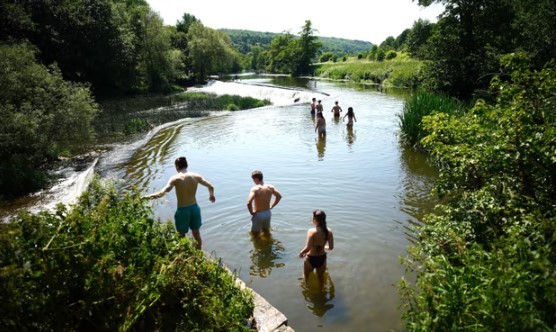
AI-Driven System Aims to Inform Public of Immediate Health Risks from Bacterial Water Pollution
In an effort to inform the public of immediate health risks from water contaminated with bacteria, real-time water quality monitors are being installed at various wild swimming locations and beaches across southern England. Wessex Water is leading the initiative, deploying sensors at three freshwater sites in Dorset, Somerset, and Hampshire, as well as two coastal locations in Bournemouth. This follows a successful pilot at Warleigh Weir near Bath, where the AI-based system accurately predicted high bacterial levels 87% of the time.
Southern Water is also testing a different monitoring system at Tankerton in Kent and Langstone Harbour in Hampshire, with plans to introduce a sensor at nearby Hayling Island soon.
Current regulations require water companies and environmental regulators to test river water for pollutants harmful to wildlife. However, there is no mandate to test for faecal bacteria like E. coli and intestinal enterococci, which can cause gastrointestinal issues, unless the site is a designated bathing area. Even then, water samples are analyzed in laboratories, and results are published a week or more after collection, with the final classification not available until November. This delay hampers immediate risk assessment from sewage or agricultural runoff.
Ruth Barden, Director of Environmental Solutions at Wessex Water, highlighted a significant criticism of the current system: "People might swim at a location all year, only to find out the quality of the water when the final classification is published."
Wessex Water chose Warleigh Weir as a testing ground for various water quality sensors and systems due to pressure from a local landowner who wanted to understand the impact of storm overflows and treatment works on the River Avon's water quality.
Barden emphasized, "We aim for people to enjoy watercourses safely. Collecting this data also helps us understand the impact of our assets on water quality and identify potential solutions."
One tested system is an AI-based approach from the UK startup UnifAI Technology. It predicts high levels of E. coli or enterococci by analyzing data from upstream sensors measuring pH, temperature, turbidity, dissolved oxygen, and ammonia. As mandated by the Environment Act 2021, water companies must install such sensors upstream and downstream of storm overflows and wastewater treatment sites.
After an initial six-month training period, where water samples are repeatedly tested for bacteria, the AI system correlates these levels with sensor data patterns. Post-training, the public can access an app providing half-hourly bacterial level predictions and water-quality alerts.
"We never assure swimmers it's safe to enter the water; it's a personal choice, and there are many safety factors. But an alert indicates potential water quality issues," explained Dan Byles, Chief Commercial Officer at UnifAI.
Wessex Water plans to install the system at three additional swimming locations – Farleigh Hungerford in Somerset, Fordingbridge in Hampshire, and Poole Park lagoon in Dorset – and at Bournemouth and Boscombe piers. Real-time swim alerts are anticipated by 2025, and discussions are ongoing with landowners and river users at 20 other sites in south-west England for potential system installations.
The technology's expansion could shed new light on how storm overflow discharges and other events affect water quality. "We can begin to create a digital twin of the river systems," Byles added.
River Action UK supports the technology but stresses the need to address the root causes of pollution. "Real-time monitoring of river pollution is long overdue and beneficial, especially if it proactively warns users of dangerous pathogen levels," said James Wallace, CEO of River Action.
He urged environmental regulators to use pollution data as evidence for enforcing the law and holding polluters accountable. "Only when compliance becomes more cost-effective than breaking the law will we see necessary investments in sewage treatment upgrades."
Southern Water is evaluating whether UnifAI's machine learning models could enhance its coastal site sensors. The company is developing its algorithms to estimate bacteria levels based on light scattering in the water. While these sensors have been operational for about a year, the data is still under scientific evaluation and not yet public, according to Southern Water.